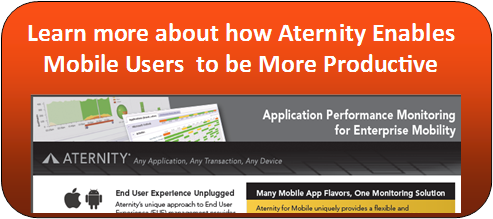Instrument Applications for Performance Management
 80% of business applications are purchased to make your organization more productive, yet none of them are instrumented for performance.
80% of business applications are purchased to make your organization more productive, yet none of them are instrumented for performance.
Applications are the reason businesses buy into information technology. The productivity gains and additional visibility software packages can shift the productivity and revenues of a business by an order of magnitude.
Unfortunately, the reverse is also true. An underutilized, poorly implemented software package can grind productivity to a halt and push end user frustration through the roof. To add insult to injury, businesses pay real dollars for software and implementations that can absolutely slam their productivity and business into the ground.
Complicating matters further, when businesses buy a new truck or piece of machinery, they can physically see it and clearly know when it is working or not. There are gauges that give a clear picture on the relative health of the equipment at any given point in time. Software is invisible and for the most part comes with few gauges to assess how well it is functioning and no gauges or metrics reflecting what impact the software is having on productivity.
Everyday businesses put their faith in applications written by people they do not know in unknown places around the world. These application developers likely do not understand how the business the application is designed to support even works, with no real motivation to want to learn how that application can make business better. I find that scary on a lot of levels, but we do have sales slicks and customer testimonials to help us all sleep better at night.
Add server, desktop and application virtualization to the mix for security, cost savings and additional productivity enhancements, with minimal performance instrumentation again, and you get another layer of fog that IT departments need to find their way through to deliver an exceptional end user experience to their end users.
So what do we do about this?
When applications and technology hardware begin performing poorly or fail, business productivity takes a hit. We naturally want the problem identified and fixed as quickly as possible to return the business to full productivity. So how do we do that?
- Do not settle for an incomplete view of what a software package is doing to and for your business. Ask the application developer to show you how your team can measure performance and productivity for your business through the application in ways that matter to you, not the application developer. Odds are this is going to be a very short, fruitless, but entertaining conversation.
- Identify the key software applications that are critical to your business and have the most direct impact to your business.
- Within each of those applications you deemed critical, identify the specific processes within that application that are the most important to meeting your productivity/revenue goals (This could be measuring how long it takes a signature card to come up for a teller at the bank, when looking at how many customers he/she can serve per hour, this might be how long it takes a job to get to the floor and loaded up in the millwork machines, every business will have its own indicators).
- Ask your application developer to build reports, dashboards and real time metrics around those key indicators for your business so you can see what your software is doing and the impact it is having on your productivity in real time.
- If your application developer does not have this capability, look at third party applications to provide this visibility, like Aternity Frontline Performance for example, that can provide this visibility for you.
- Select metrics that are predictive in nature for your business, that are real time and exactly accurate that you can build baselines off of and trending over time.
- Refine the metrics to capture and measure until you are getting a complete picture that allows you to make both in-the-moment adjustments and informed long range strategic decisions.





Leave Comment